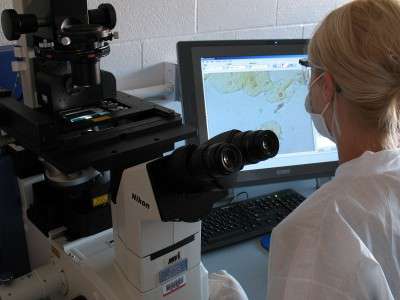In shows like “Law & Order” and “CSI: Crime Scene Investigation,” it only takes an hour to nab the perpetrator of a crime. And thanks to the creation of a new computational tool by Catherine Grgicak, assistant professor of biomedical forensic science at the Boston University School of Medicine, this short time frame for analyzing DNA evidence might soon be applicable to real life.

Grgicak has created the prototype stages of a computational tool dubbed NOCIt for “Number of Contributors.” This tool is part of a larger project that emerged in 2011 and continues to focus on developing more accurate analyses of DNA found at crime scenes.
“And that’s where we come in,” Grgicak said. “We want to study, basically, ways in which we can interpret these samples, and we want to know tools that would allow analysts to interpret [them].”
Crime scenes specifically provide a breeding ground for complicated, genetic observation, she said. One of her research team’s goals is to serve the title “Number of Contributors” justice by identifying the number of sources that could contribute to a DNA sample, yielding the strength of DNA-to-suspect matches.
“Once the evidence becomes very, very complex, it becomes very, very difficult to answer these questions using a [Microsoft] Excel spreadsheet or a piece of paper and a calculator,” Grgicak said.
She illustrated an example of this issue by way of a doorknob. If a “person of interest” touches a doorknob at a crime scene, his or her fingerprints are available for observation. But if others touch the doorknob as well, the original person of interest’s DNA can be obscured, making for inaccurate or incomplete assumptions by criminal investigators.
In order to clear up this forensic confusion, Grgicak’s “computational tool” is less tangible and more mathematic. The use of statistics and development of algorithms have provided the base for the project since 2011, and have been expanded due to a $2.5 million grant from the U.S. Department of Justice and the Department of Defense on Oct. 27. The project currently takes the form of a software system available on the BU Biomedical Forensic Sciences website.
“It [DNA] is basically this sequence of four bases: adenine, guanine, cytosine and thymine,” said John Celenza, an associate professor of biology and director of the biochemistry and molecular biology undergraduate program in the College of Arts and Sciences. “But because in our DNA we have over ten-to-the-ninth [1 billion] bases, it’s the sequence of those bases that are going to be different for every person.”
Aside from avoiding the misinterpretations of mixed samples, one of the goals of the project remains to increase the accuracy of matching clear DNA signals to evidence from individuals, Grgicak said.
DNA is an accurate identification resource, which makes it ideal for singling out suspects in a crime scene, Celenza said.
“Each of our genomes is pretty much a unique fingerprint,” he said. “With the size of the human genome, if you see a match — if you can get a very statistically significant match — then that’s the only person who can match that [DNA sample].”
Lauren Alfonse, a second-year graduate student at BUSM and graduate research assistant to Grgicak, said the team’s work could even apply to fields beyond forensics. She presented some of their work to the American Society of Human Genetics in October.
“It was mostly geneticists and doctors and lots of medical applications of genetics,” Alfonse said. “We think we might be able to introduce a lot of the forensic stuff that we’ve been working on.”
And with help from colleagues at the Massachusetts Institute of Technology and Rutgers University-Camden, Grgicak is not alone in her endeavors. She said she hopes her diverse team of biologists, forensic scientists, statisticians, computational biologists and engineers will learn from the computational prototype and further advance it into a useful tool for crime labs.
“It’s really an interdisciplinary collaboration between the four institutions trying to develop these tools,” Grgicak said. “I believe that if one could develop a system, a computer system or software system that would allow more complex systems to be analyzed, then that’s important.”




